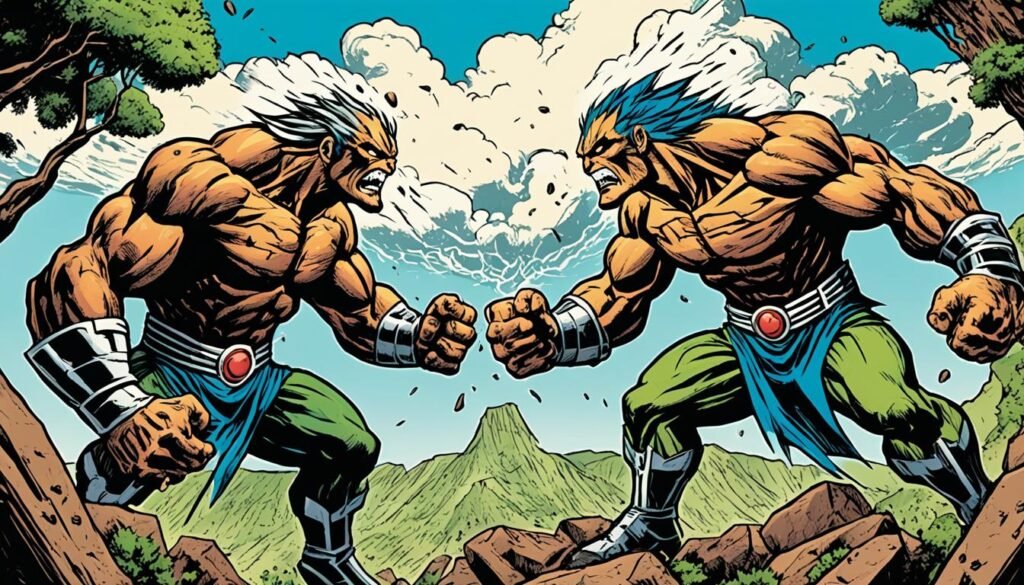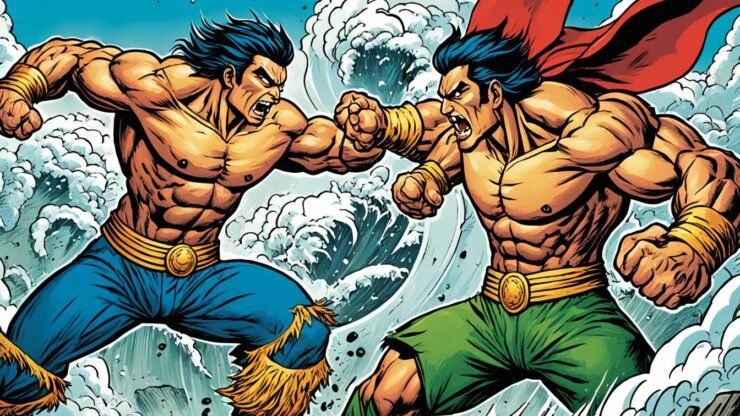Inside the vast world of Philippine folklore, an engaging story is told. This tale is about Kayumang and Kasili, two powerful figures in a grand battle that shakes the earth itself. It leaves behind a curious and fascinating trail. This story shows the strong oral tradition and the appeal of mythical titans from old times.
On an beautiful but isolated island, a farmer and his family lived peacefully. They didn’t expect a great storm would change everything. This storm destroyed their crops and led to a big fight between Kayumang, an earth titan, and Kasili, a water god. The farmer realized the true power of these mythical titans during this crisis.
Key Takeaways
- The legend of Kayumang and Kasili is a fascinating part of Philippine folklore. It explores the nation’s deep mythology.
- This account showcases the massive fight between earth titan Kayumang and the water god Kasili. It causes the earth to shake.
- Oral traditions have been key in keeping and sharing these stories. They reveal the Filipino spirit and historical heritage.
- The story gives a peek into the bond between people and the environment. It touches on wisdom, being clever, and the bad side of greed.
- Many Philippine literature and art pieces have been inspired by the Kayumang and Kasili tale. It keeps the story alive in today’s world.
Introduction to Philippine Folklore
The Philippines is a land with many ethnic groups, each having its special cultural stories and traditions. These stories, part of Philippine mythology, show the country’s lively ancient beliefs. For centuries, the Filipino people have used storytelling to keep these myths alive.
The Richness of Philippine Mythology
Philippine folklore is mainly shared through stories passed down by word of mouth. This method helped these stories change and grow over time. Sharing these tales not only connects people with their heritage but also links them to the past.
Importance of Oral Traditions
Oral traditions are key in keeping and sharing Philippine tales. Popular stories like “Juan Gathers Guavas” and “The Battle of the Crabs” show how these traditions endure. Writers like Laura Watson Benedict helped by recording these stories for future generations.
The Titans: Kayumang and Kasili
Kayumang: The Mighty Earth Titan
Kayumang is at the center of a Philippine folklore. They are a strong earth titan, representing the raw power of nature. This titan is the protector of the land, known for their huge strength. They keep the earth’s harmony. Thus, Kayumang shows the strong bond between people in the Philippines and their land.
Kasili: The Fearsome Water God
Kasili is a powerful water god, unlike Kayumang. He rules over the vast seas. He is seen as both caring and destructive towards sea life. This figure symbolizes the sea’s ever-changing and risky aspects. It points out the fragile link between humans and nature.
The Tale of the Quaking Earth
A farmer and his big family lead a peaceful life on a lush, isolated island. They are happy, not knowing about forces from afar. But their peace is shattered by a massive storm. This storm ruins the farmer’s crops and starts a huge problem for him. Now, he must figure out what’s going on and fix things for his family.
The Farmer’s Bountiful Island
For a long time, the farmer’s family thrived on their island. Their hard work in farming fed everyone in their community. The beauty of their fields and orchards spoke of their success. But everything they knew was soon to change.
The Wrath of the Water God
As the farmer searches for answers, he learns about the water god, Kasili. Kasili is upset with the farmer for some reason. He shows his power by making the earth shake violently. This puts the island in great danger. The clash between the farmer and Kasili is now inevitable.

Kayumang, Kasili, and the Quaking
The story reaches its peak with a massive battle. Kayumang, the earth titan, fights the water god, Kasili. The earth starts shaking as they clash, showing the power of their fight. A poor farmer and his family are in the danger zone. Their world is about to change as the titans battle. This battle is the heart of the story.
Kayumang and Kasili‘s fight rings true to the rich Filipino tale tradition. Scholars like Clara Kern Bayliss have kept these stories alive. They explore myths, natural events, and the balance of life with stories like Bagobo Myths. These tales are cultural treasures.
The earth shaking from Kayumang and Kasili‘s fight is key. It shows the belief that everything is connected in Philippine myths. This echoes in other favorite Filipino stories. For example, The Monkey and the Turtle talk about trust and betrayal. And How the Farmer Deceived the Demon shares lessons about facing challenges.
The amazing battle between Kayumang and Kasili shows more than a fight. It’s about the earth’s delicate balance and our link to it. This story is part of the Philippines’ rich culture. It teaches valuable lessons. The power of these stories to teach and inspire never fades.
The Demon’s Red Fruit Tree
The captivating story of “The Clash of Titans: Kayumang, Kasili, and the Quaking Earth” includes a mysterious tale. It tells of a special “demon” guarding a tree with big, bright red fruits. A poor farmer finds this tree and eats the sweet fruit, beginning a chain of events. These events complicate the fight between the strong earth titan, Kayumang, and the terrifying water god, Kasili.
This supernatural twist makes the story even more intriguing and risky. Now, the farmer must deal with the demon’s challenges. This includes making deals and facing the results to help his family. The adventure tests his cleverness and courage against cosmic peril.

The story continues to dive into the mystery of the “demon” and the farmer’s interaction. This highlights the mix of natural and supernatural in Filipino stories. The farmer’s journey brings us through eerie and real-life human struggles.
Works like “The Demon’s Red Fruit Tree” celebrate the rich mythical tales from the Philippines. It brings attention to a cultural heritage filled with wonder. From Visayan folk tales, Tagalog legends, to Bagobo myths these stories fascinate people. They carry timeless wisdom and values.
| Folk Tale Collection | Noteworthy Stories |
|---|---|
| Visayan Folk-Tales by Berton L. Maxfield and W. H. Millington | “The Two Wives and the Witch”, “Why Dogs Wag Their Tails” |
| Tagalog Folk-Tales by Fletcher Gardner | “The Adventures of Juan”, “The Silent Lover” |
| Bagobo Myths by Laura Watson Benedict | Myths related to natural phenomena like cosmogony and the story of the eclipse |
“The Monkey and the Turtle” explores the story of betrayal and enmity. This leads to a deep-rooted rivalry between monkeys and turtles.
The story of the “demon’s red fruit tree” adds fascinating supernatural elements. These elements bring more depth and excitement to the tale. It hooks the reader and shows the wonder of Philippine folklore. Here, the line between real and supernatural stories often blurs.
The Farmer’s Deception
The farmer faces harsh times due to the titans’ clash and the water god’s anger. To ensure his family’s safety, he uses a smart trick. He outsmarts the demon protecting the red fruit tree, getting food and protecting his family. This trick shows the tough choices people make in hard times.
Outwitting the Demon
The farmer comes up with a smart plan to trick the demon guarding the red fruit tree. He needs to protect his family. So, he finds a way to distract the demon and gets food from the tree. This quick thinking saves his family from hunger during the disaster.
The Consequences of Greed
But, tricking the demon also brings trouble. It shows how wanting more, even to protect loved ones, can cause harm. The farmer’s actions, though for his family’s safety, lead to more dangers. This story warns us about the high cost of selfish actions, even in bad situations.
Symbolism and Lessons
Kayumang and Kasili’s clash and the shaking earth symbolize nature’s immense power and perfect balance. It shows how fragile humans are against such forces. The story warns about the results of disturbing nature’s harmony.
Nature’s Fury and Balance
This story highlights the fine balance in the natural world. Kayumang and Kasili, mighty titans, stand for earth and water. Their fight shakes the earth, putting a farmer and his family in danger.
The story teaches us to live in peace with the forces that make our world.
Wisdom and Resourcefulness
Besides nature’s might, the story also praises human wit and skills. The farmer uses his cleverness to beat both titans and a guardian demon. This shows the power of thinking fast when facing tough times.

Cultural Significance
The clash of Kayumang, Kasili, and the quaking earth tells a story dear to Filipinos. It shows their respect for nature and the power of overcoming challenges. The tale reflects the deep connection Filipinos have with their environment.
Reflecting the Filipino Spirit
This myth is more than a story; it’s a mirror of Filipino culture. It talks about respect for nature and shows how people face struggles with creativity. It underlines the deep bond Filipinos feel with their surroundings.
The farmer’s story highlights the Filipino trait of finding solutions when faced with problems. It showcases the country’s rich folklore and the strong spirit of its people. Indeed, it’s a testament to the Filipino culture and identity.
Preserving Oral Traditions
The popularity of stories like Kayumang, Kasili, and the Quaking Earth shows how powerful oral tradition is in the Philippines. These stories have been handed down through time. Each telling adds new depth and understanding. Speaking these stories keeps communities close and passes on important cultural knowledge. It makes sure the lessons in them live on.
Passing Down Folklore
It’s vital to save Philippine folklore, including the stories of Kayumang and Kasili. Documenting these tales and translating them spreads their wisdom to more people. This effort helps preserve Filipino culture, keeping its identity strong. It ensures these vital stories live on for future generations.
Keeping Heritage Alive
Sharing Philippine folklore, including Kayumang, Kasili, and the Quaking Earth, is key to keeping the culture alive. In a world that’s quickly changing, these stories connect younger Filipinos to their past. They help the values and spirit of these tales stay relevant today. They continue to guide what being Filipino means.

Related Philippine Myths
The story of the Kayumang, Kasili, and the Quaking Earth is part of the rich tapestry of Philippine folklore. It highlights the complex nature of the country’s mythical tales. Another tale, “The Monkey and the Turtle,” focuses on the relationship between its two main characters. It shows how their choices lead to impactful outcomes. These stories give us a glimpse into the heart of the Filipino culture through their beliefs and views.
The Monkey and the Turtle
“The Monkey and the Turtle” is a popular Philippine folktale. It tells of how a monkey and a turtle form an unlikely partnership. This partnership focuses on themes of cleverness, betrayal, and life’s natural power dynamics. Like the tale of Kayumang and Kasili, it draws from the close relationship Filipinos have with their surroundings. It teaches valuable lessons from the natural world.
Other Nature-Inspired Tales
Philippine folklore features numerous myths inspired by nature, much like the Kayumang and Kasili story. These tales often include animals and spirits, highlighting the importance of the balance between people and nature. Studying these legends offers insight into the deep connection Filipinos have with the environment and the mysterious elements within it.
Modern Interpretations
Adaptations in Literature and Art
The Kayumang, Kasili, and the Quaking Earth story remains a favorite. It has inspired many forms of expression like books, plays, and art. Filipino authors, artists, and playwrights have reinvented this myth for current audiences. They keep the story’s core while making it fresh and meaningful today.
Clara Kern Bayliss’ novel, Philippine Folk Tales, is a great example. It includes the Kayumang and Kasili myth. This story is part of a larger collection of Philippine folklore. It connects old myths with new readers.
Similar works can be found in the Visayan Folk-Tales collected by Maxfield and Millington. They offer a different view of the earth titan and the water god’s clashes. The tales are part of a varied exploration of the Philippines’ storytelling traditions.
Playwrights have also reimagined the myth for stage performances. These plays not only entertain but also delve into deep themes. They explore how we interact with nature, the dangers of greed, and the strength of people. This gives the story new life on the contemporary stage.
Visual artists, too, have taken inspiration from the story. They create paintings, sculptures, and more based on the myth. These pieces highlight the epic battle, the trembling earth, and the farmer’s plight. This artwork shares the story in a visually captivating way.
With literature, theater, and art, the story stays alive. It captivates new generations. Through these mediums, the wisdom and culture of the Kayumang, Kasili, and the Quaking Earth saga remain relevant in today’s world.
Folklore in the Digital Age
In this digital era, sharing Philippine folklore tales has become easier. Stories like Kayumang and Kasili are now on websites, social media, and digital archives. They are reaching more people globally, sparking interest and appreciation for the Philippines’ cultural history.
Sharing Stories Online
Philippine folklore, including the Kayumang, Kasili, and the Quaking Earth story, is widely available online. These ancient tales can be found on websites, social media, and digital archives. This digital sharing helps people everywhere learn about and love Filipino culture.
Preserving Cultural Identity
Sharing and saving Philippine folklore, like the Kayumang, Kasili, and the Quaking Earth story, is vital. As the Philippines changes quickly and becomes more global, these stories keep younger people connected to their roots. They ensure that the wisdom and spirit of these old tales continue to influence the Filipino culture.

Conclusion
The story of Kayumang, Kasili, and the Quaking Earth shows how strong Philippine folklore is. This tale is based on different cultural backgrounds in the Philippines. It gives us a glimpse into how Filipinos see the world and their deep connection with nature.
Sharing these tales helps keep Philippine culture alive. It spreads the wisdom in the stories to inspire future generations. The world becoming more connected makes these efforts even more important. They help us understand and respect the stories that come from different places.
Stories like Kayumang, Kasili, and the Quaking Earth teach us important lessons. They remind us of our close ties to nature. They also show how humans can overcome tough times with strength. By celebrating these stories, we celebrate the rich history of the Philippines. This keeps the dialogue alive, connecting people around the world. The story of Kayumang, Kasili, and the Quaking Earth will keep inspiring for years to come.

